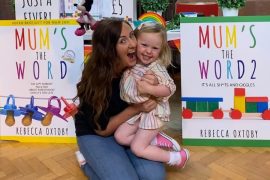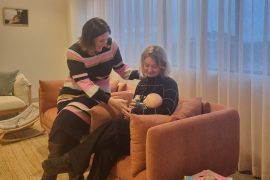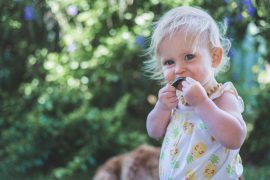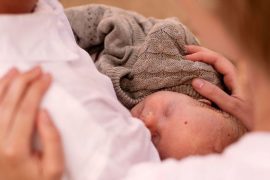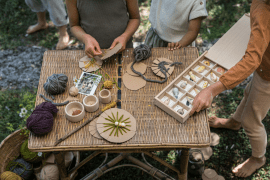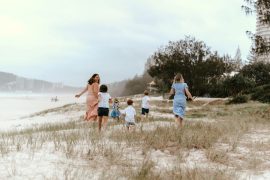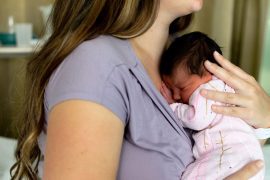On a practical level, I used diapers/nappies when we were out and about (I love those Weenies pilchers!), and peed her as much as I could, but I didn’t expect to be perfect in these, or any, circumstances. We used toilets or took the bucket (or a plastic container with a tight lid) in the car. When we missed a pee, my reaction was just, “Oh well, missed that one.” On hot days, I would lay a flat cloth diaper/nappy on the car seat. If it wasn’t convenient to stop, I’d say to her, “Oh, Maia, you’ll have to pee in the nappy, and I’ll change it as soon as we stop.” Maia didn’t like to be disturbed at night in the early months, so I’d lay her on an absorbent cotton rug and just let her pee. I changed this whenever I woke up. (I also had a hot-washed woolen blanket underneath, to protect the mattress.) Or I’d wrap a cloth diaper/nappy loosely around her bum and change it when wet. I found that, as with naps, she usually peed on awaking and then nursed.
Around 6 to 7 months, Maia went “on strike”, coinciding with teething and beginning to crawl. She stopped signaling clearly and at times actively resisted being peed. I took it gently, offering opportunities to eliminate when it felt right and not getting upset when, after refusing to go in the laundry tub, she went on the floor. Even on bad days, though, we still had most poops in a bowl, bucket or the toilet.
At nearly 10 months, we were back on track. I noticed that as she became more independent and engrossed in her activity, she was not keen to be removed to eliminate, so I started to bring a receptacle to her. She preferred a bowl or bucket on my lap, and later we began to use a potty: I initially held her while she used it. At nighttime, I started sitting her up on the blue bucket (and on the breast at the same time; tricky to lie down afterwards and not spill the bucket!). When I was less alert, she peed on a nappy between her legs and/or the cotton rug underneath her.
Yes, it’s been great to do less than a full load of washing each day for a family of six, but much more significant is the learning that mothers and babies are connected very deeply – at a “gut level” – and that babies (and mothers) are much more capable and smart than our society credits.
There was a marked shift soon after she began walking at 12 months, and by 14 months, to my amazement, Maia was out of diapers/nappies completely. She now was able to communicate her needs very clearly, both verbally and non-verbally, and her ability to hold on was also enhanced. When she needed to eliminate, she said “pee” and/or headed for the potty – we had several around the house. She began to be very interested in the fate of her body products, and joined me as we tipped it onto the garden or into the toilet. Later she wanted to “tip it” and even began to get a cloth and wipe up after herself!
With this change, I stopped using diapers/nappies altogether, and switched to trainer pants for outings – the Bright Bots brand are great, and come in small sizes. Dresses are great too, for summer outings with bare-bottomed girls. By the middle of her second year, Maia was totally autonomous in her daytime elimination. She could tell us her needs (with lots of warning) and/or go to the potty herself.
Night times continued to be busy for us, with lots of feeding and peeing, but, unless she was unwell, or I was very tired, we had very few misses, and sitting up at night to pee her seemed to me a small effort in return for the benefits we were reaping. It seems, from other stories, that many EC babies stop peeing at night even in the first year, or have a predictable pattern (e.g. not peeing after midnight).
Compared to my other babies, Maia has been a very light sleeper, day and night. Around age 2, I began to persuade her to wake less frequently by refusing to feed her until early morning and with this, she stopped peeing most nights.
For me, the beauty of elimination communication has been in the process, not in the outcome. Yes, it’s been great to do less than a full load of washing each day for a family of six, but much more significant is the learning that mothers and babies are connected very deeply – at a “gut level” – and that babies (and mothers) are much more capable and smart than our society credits.
I have experienced EC with only one baby, starting at a young age. Many women in many places have done it differently – started from birth or with an older baby, made less or more use of diapers/nappies, taken a long time or a short time to catch on, done EC part-time or full-time and some women have even begun work outside the home and trained their baby’s carers in EC. (For wonderful accounts of EC all over the world, see the book Infant Potty Training)
If you feel drawn to EC, I encourage you to have a go. Look on the internet – it’s all I needed to get started, as well as invaluable on-going support.
There are also several great books – and you can ask other ECers, as well as mothers from cultures such as India and China where this practice is still widespread. Although it can be more complex for older babies, some of whom may have already learned to ignore their body’s signals, others may welcome the chance to communicate their elimination needs.
I wish you ease, pleasure and mindfulness in your mothering.
This article appeared in issue #3 of The Natural Parent Magazine.
Dr Sarah Buckley is a NZ-trained GP, also trained in GP obstetrics. She is the author of the internationally best-selling book Gentle Birth. Gentle Mothering and the scientific report Hormonal Physiology of Childbearing, published with Childbirth Connection (US) .Sarah is also the mother of four children, all naturally born and naturally raised, now in their teen years and beyond. Sarah is currently combines mothering with her work as a writer and lecturer on pregnancy, birth and parenting, and is also a PhD candidate at the University of Queensland in Brisbane, Australia. For more of her work, see www.sarahbuckley.com

